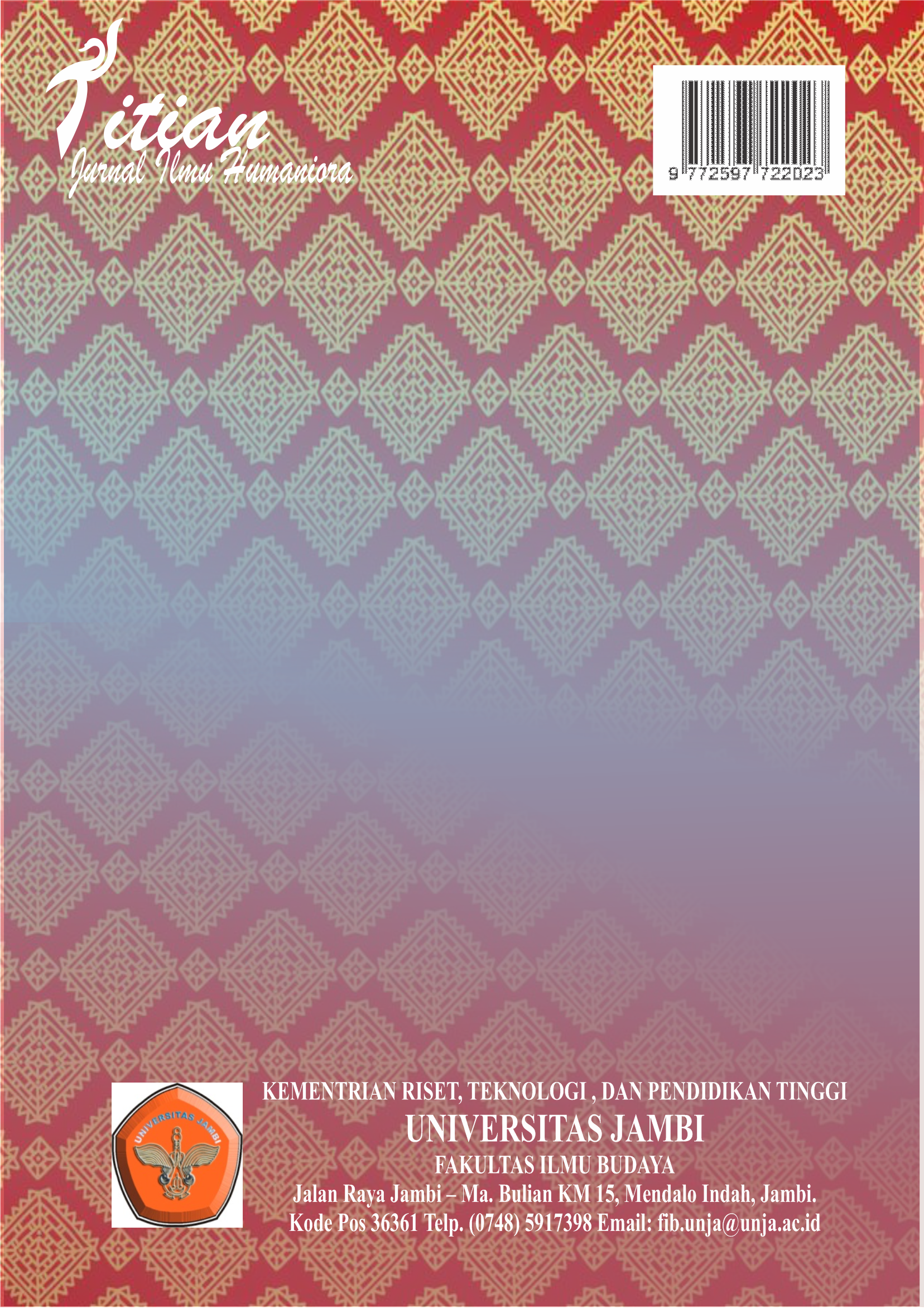Representation of Feminism in the Film of Jane Eyre (2011): Semiotics Analysis Study of Charles Sanders Peirce
DOI:
https://doi.org/10.22437/titian.v5i2.15283Keywords:
Feminism, Film, Representation, SemioticsAbstract
This study aims to represent feminism in a film entitled Jane Eyre through elements of Charles Sanders Peirce's Theory of Semiotics. The science of Semiotics used in this study serves as a basis for interpreting the signs found into a clear meaning. By using descriptive qualitative method, the researcher analyzes signs that contain hidden meanings in Jane Eyre's film, which is based on a novel with the same title by Charlotte Bronte. The researcher uses the data found in the film and then analyzes it to be able to interpret it using Pierce's Semiotic Theory. The subject of this research is the Jane Eyre film with the object of research being the scenes which represent the feminism of the main character Jane Eyre. The results of the research conducted, researchers found the meanings of representation of feminism that can be interpreted through the characters, scenes, and properties used in the film. The conclusion of this study is the representation of feminism in the Jane Eyre film which is reflected in the main character Jane Eyre.
Downloads
References
Adhi Kusumastuti, F. T., & Khoiron, A. M. (2019). Metode Penelitian Kualitatif. Lembaga Pendidikan Sukarno Pressindo.
Ahmed, H. R. (2020). Philosophy of Feminism and Suffering of Western Women Concurring to Charlotte Bronte’s Novel “Jane Eyre.†Electronic Research Journal of Literature, 2, 45–52.
Alfiyatun, D. (2019). Jogja-NETPAC Asian Film Festival (JAFF) Sebagai Media Komunikasi dalam Membangun Citra Jogja di Kancah Perfilman Asia Tahun 2018. Universitas Mercu Buana Yogyakarta.
Andriadi, A. (2013). CHARLOTTE BRONTTE. Diglossia: Jurnal Kajian Ilmiah Kebahasaan Dan Kesusastraan, 5(1).
Belsey, C., & Moore, J. (1997). The feminist reader: essays in gender and the politics of literary criticism. Palgrave Macmillan.
Budiman, K. (2011). Semiotika visual: konsep, isu, dan problem ikonisitas. Jalasutra.
Cushman, S., Cavanaugh, C., Greene, R., Ramazani, J., & Rouzer, P. (2012). The Princeton Encyclopedia of Poetry and Poetics. New Jersey, USA: Princeton University Press.
Danesi, M. (2012). Buku Teks Dasar Mengenal Semeotika dan Teori Komunikasi. Yogjakarta: Jalasutra.
Freedman, E. B., & Jacobs, E. (2004). No turning back: the history of feminism and the future of women. Labour, 54, 335.
Gao, H. (2013). Reflection on Feminism in Jane Eyre. Theory & Practice in Language Studies, 3(6).
Hall, S. (1997). Representation: Cultural representations and signifying practices (Vol. 2). Sage.
Jackson, S., & Jones, J. (2009). Pengantar Teori-Teori Feminis Kontemporer. Yogyakarta: Jalasutra.
Juliastuti, N. (2000). Kebudayaan yang Maskulin, Macho, Jantan, dan Gagah. Artikel Dalam Jurnal KUNCI “Maskulinitas†Edisi, 8.
Loh, L. (2015). Intersectionality in Jane Eyre and Its Adaptations.
Lopez, M. P. S. (2012). Film Genre, Narrative and Directorship: Representations of Feminism in Jane Eyre. Simmons College.
MA, M., & Wardani, C. A. (2009). Teori Komunikasi. Bogor: Ghalia.
Myers, L., & Hannam, K. (2007). Women as backpacker tourists: A feminist analysis of destination choice and social identities from the UK. In Backpacker Tourism (pp. 174–187). Channel View Publications.
Pradopo, R. D. (1998). Semiotika: Teori, Metode, dan Penerapannya. Humaniora, 10(1), 42–48.
Sobur, A. (2009). Semiotika Komunikasi, Bandung: PT Remaja Rosdakarya. Wacana Media.
Sobur, A. (2012). Analisis Teks Media, Cet 6. Bandung: Remaja Rosdakarya.
Sobur, A. (2013). Semiotika Komunikasi (cetakan kelima). Bandung: Rosdakarya.
Wibowo, I. S. W. (2013). Semiotika komunikasi: aplikasi praktis bagi penelitian dan skripsi komunikasi. Jakarta: Mitra Wacana Media, 17.
Downloads
Published
How to Cite
Issue
Section
License
Copyright (c) 2021 Rima Sarah

This work is licensed under a Creative Commons Attribution-ShareAlike 4.0 International License.
































